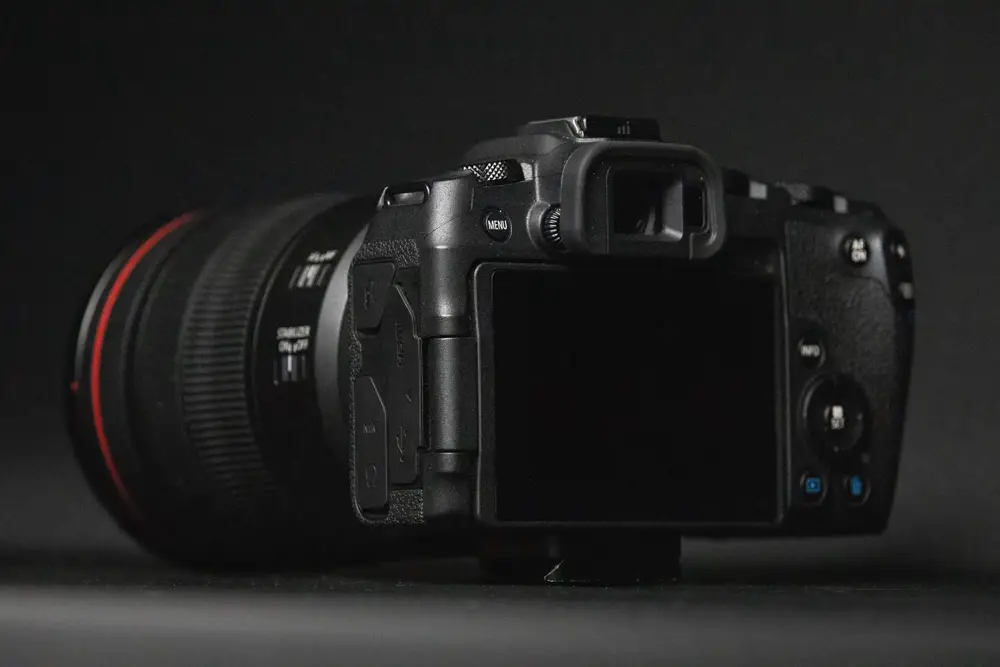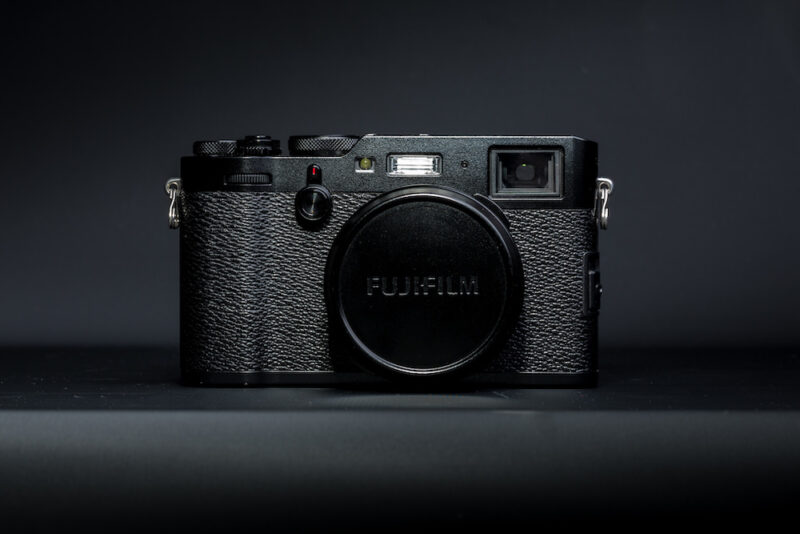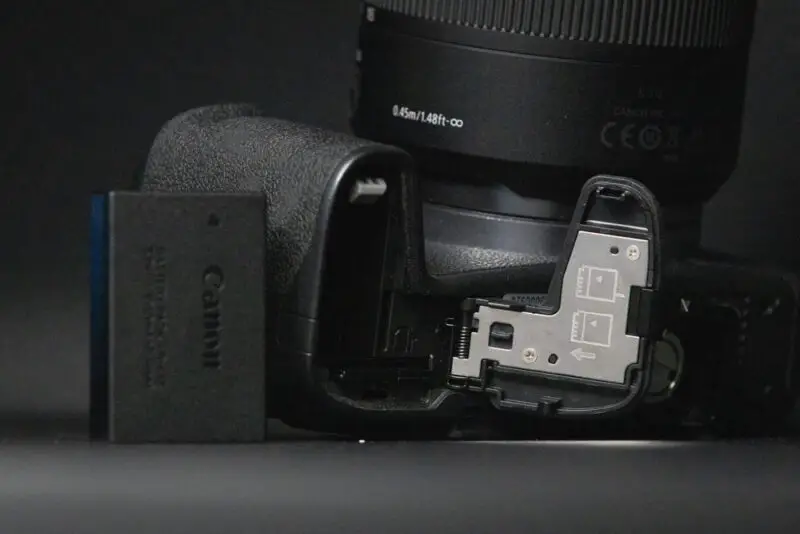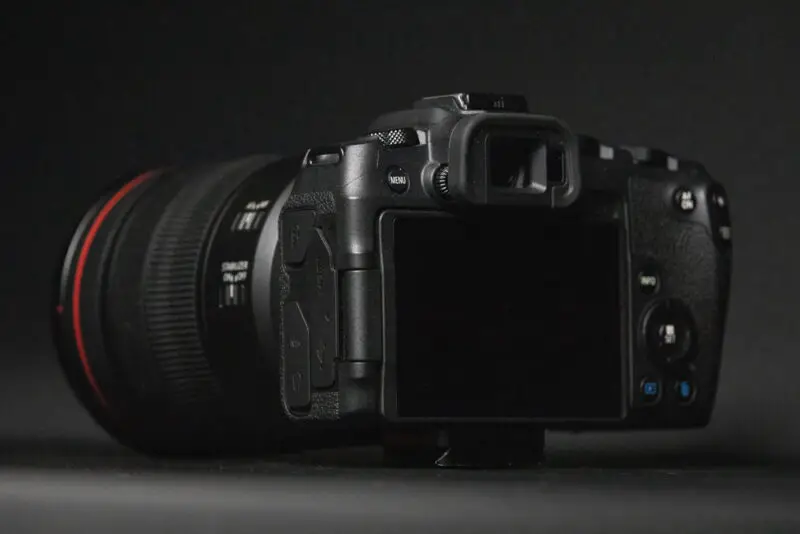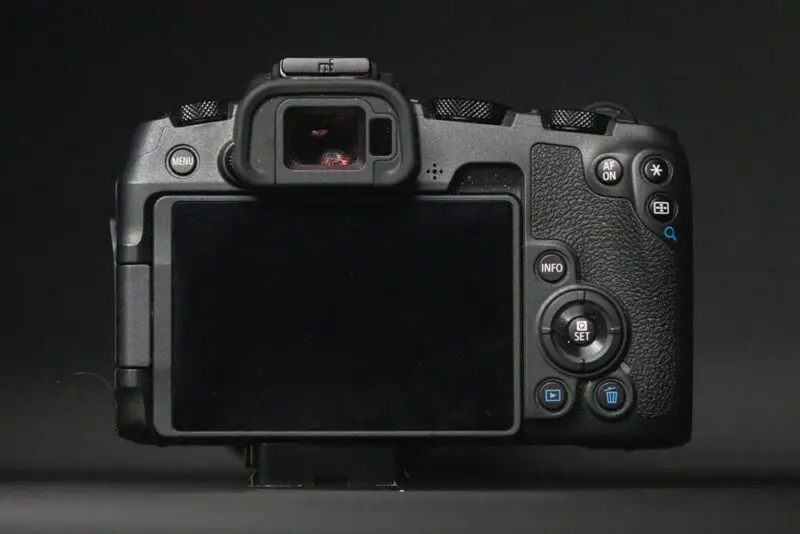When it comes to viewfinders, cameras nowadays come in three shapes: with an EVF, with an OVF, or without a viewfinder. Camera EVF stands for an electronic viewfinder. On the other hand, OVF stands for an optical viewfinder.
The choice between a camera with an EVF or an OVF isn’t that simple. However, it won’t be a choice soon in a world where the mirrorless camera is dominant. Photographers that prefer OVF cameras will have to work with systems that will become outdated and unsupported by the manufacturers.
What Is A Camera EVF?
The electronic viewfinder in the camera is essentially a tiny display stationed behind a magnifying glass where you see what the camera sees.
In this case, the camera EVF shows a readout from the camera sensor. In other words, you are seeing what the camera sensor sees. That includes digital processing and everything, the perks, and the limitations of seeing through the camera sensor.
What Is A Camera OVF?
The optical viewfinder in the camera is a system that consists of a prism, a mirror, and ground glass. Those reflect the light the lens focuses on the sensor up towards your eye.
In this case, you are seeing what the lens sees. There is no digital processing, just the unfiltered world in front of the camera.
What About Cameras Without A Viewfinder?
Some cameras do not have a viewfinder or have a rangefinder which isn’t the traditional viewfinder.
Cameras that don’t have a viewfinder (and are digital) usually use the back LCD display as a makeshift electronic viewfinder, just like the camera on your smartphone.
The rangefinder cameras don’t have the classical viewfinder due to the fact that you aren’t looking through the lens. Instead, you look through an opening independent of the lens where you use overlapping images to focus.
What Are The Pros And Cons Of A Camera EVF Compared To OVF?
Just like any other gadget or system, everything has pros and cons. The EVF is no different. There are aspects about it that are good and aspects that are not. There are instances where the OVF is dominant. Let us dive into that.
Camera EVF Pros
What You See Is What You Get
Since the EVF provides a readout from the sensor, it shows how the photo will look for your current camera settings. Well, almost.
If your shutter speed is slower than the EVF refresh rate, you will get a “simulated” look. The simulated look will correct the brightness of the preview but will not show the effect of the long exposure. In other words, if you want to see light trails in the EVF before you take a shot, you probably won’t.
On the other hand, with the OVF, you see the world as it is through the lens. No digital processing.
Camera EFV Provides More Data On Screen
Since the EVF is effectively an LCD or OLED screen, it means that everything you see comes from a signal processor. That said, just like the menu on the LCD screen, the EVF can have a graphical user interface with a bunch of data displayed on it.
Most cameras can display a live updated histogram, a horizon level. Some even show focus peaking, focus assists, zebras, and so forth. The amount of data that is displayed on the EVF screen depends on the camera and the manufacturer.
https://www.youtube.com/watch?v=uOU5hkCLFqE
All this is often available in real-time, which can make your life a lot easier.
OVF cameras have plenty of data in the viewfinder as well. Some even have LCD overlays to display data. From light meters to settings and horizon levels, you’ll find plenty there. But there can’t be a histogram, focus peaking, focus assist, zebras, and so forth.
Picture Preview On The Camera EVF
One great thing that the EVF eliminates is chimping. You can preview the shots you take on the EVF itself, so you don’t have to remove the camera from your eye to peek at the back LCD.
Often this proves to be faster for some photographers. Other photographers find that distracting. I guess it is a matter of taste. However, the option is there if you need it.
Photographers with DSLRs have to contend with chimping. It is what it is.
No Blackout (Almost)
Given that the EVF provides a readout from the sensor, it means that there is no flapping mirror to black the viewfinder out during a shot. That said, there is a pause – image retention of the last frame before the exposure has started, which ends when it stops.
If the exposure is shorter than the refresh rate of the EVF with the newer cameras, there is no pause or blackout. Of course, for this to happen, you need to use the electronic shutter, not the mechanical shutter.
Cameras with OVFs have blackouts caused by the mirror flipping up and down. With the more advanced DSLRs, this blackout is short, and you get used to it quite fast.
Recording Video Via The Viewfinder
Most cameras these days have advanced video features. Mirrorless cameras that feature an EVF allow you to record video while previewing it in the EVF. That is extremely useful when you record video in bright conditions, and the LCD isn’t that visible.
Videographers with DSLR cameras only have the back LCD preview for video recording.
The EVF Allows You To See In The Dark
Since the camera can see in the dark much better than you by utilizing digital signal processing and signal boosting (ISO), this means that you can see much better in the dark via the EVF. That comes in handy for framing up your shot in the darkness.
Yes, the image will be messy because the camera will boost the ISO higher, so it provides at least 60 FPS for the viewfinder, but it will be enough for you to frame up your shot.
Depending on the lens, however, an OVF can provide a bright enough preview so you can frame up your shot.
Cameras Can Have Higher Burst Rates Due To The EVF
Mirrorless cameras have the advantage of having high burst rates when using the electronic shutter. The main culprit for this is the EVF.
DSLR cameras have a mirror box, which is necessary for the OVF and the focusing system. The mirror box is a limiting factor for the burst rate. There is a mechanical limit on how fast it can actuate before it starts to fall apart.
With the introduction of the EVF, there is no need for the mirror box anymore, so the cameras have only the shutter mechanism (for the mechanical shutter mode) or the processor speed and sensor readout (for electronic shutter mode) to be the limiting factor in the burst rate.
Even with the mechanical shutter, cameras without the mirror box achieve faster shutter speeds. The 1DX Mark III can shoot 16 FPS in regular mode, but it achieves 20 FPS in live view mode, where the mirror is locked up.
OVF cameras are at a clear disadvantage when it comes to burst rates. There is no getting around the physics here.
Camera EVF Cons
What You See Is What You Get – But Not With Flash
The EVF can provide a preview of what your photo will look like. However, when you introduce a flash or multiple flashes into the equation, you run into problems. If you are lucky, your EVF will show you the preview for your ambient light without flash.
Some Sony cameras try to anticipate how much light the flash will produce and then brighten the whole scene as it is the ambient light. To avoid it, you have to set up a button and press it every time you want to preview the ambient light. That can be a hurdle.
Being able to see the ambient light only means that you’ll have to turn off and on exposure simulation, so you can compose the shot and then judge the ambient light separately. That forces you to lose valuable time fiddling with buttons, and the menu, instead of shooting or setting up your shot.
Sadly, with an OVF, all you have is the light meter, which will tell you where your current settings will land the exposure. Otherwise, you are seeing everything.
Lag And Motion Sickness Due To It
When you are using an optical viewfinder, you see with the speed of light. With the EVF, the delay between what happens and when you see it depends on how fast the camera processes the sensor data and the sensor readout speed.
The EVF will always lag behind a couple of milliseconds from the action. Even with the fastest sensors and camera processors. With the latency getting lower and lower with each generation of cameras with EVFs, it might become fast enough for it not to be an issue.
However, photographers who shoot fast-moving subjects that rapidly change directions often find themselves in a situation where the EVF can not keep up with the action and track the subject.
That forces the photographer to shoot with both eyes open. That can be a simple workaround. However, your left eye getting a picture that has motion and lags different from your right eye will end up making you feel motion sickness. I’ve experienced this first hand.
Cameras with OVF, on the other hand, do not introduce lag. Therefore there is no motion sickness.
EVF Flicker
Not all camera EVFs are created equal. They come in different sizes, resolutions, and refresh rates. Some are LCD, while others are OLED.
However, depending on your eyes capabilities, you might end up seeing the EVF flicker on some cameras. I personally can see the flicker on an A7III, but not on an EOS R. Then again, I can see the flickering on most cheap LED lights too.
Even if you don’t see the flicker, the light can have a short flicker pulse. That means that the backlight has one high-intensity pulse, and then it is off until the next cycle. The pulse not being less intense but lasting longer can lead to eye strain and headaches. That is an issue plaguing big LED screens often found on billboards.
Blackout Free But Not Freeze Free
Some EVFs, or specifically some cameras, suffer from so-called frozen frames.
When you take a photo, the sensor can’t provide a readout for the EVF, so the camera shows the last frame generated for the EVF and then replaces it with the photo taken until it is able to initiate the sensor readout for the EVF again. During that time, all you can do is look at your last frame while being prevented from seeing the action happening.
Even though this plagued older mirrorless cameras more, it can happen with cheaper mirrorless cameras of the current generation.
Battery Drain
If you want to see what is going on through the EVF, the sensor needs to work full time. That means the sensor and the EVF need to be powered on all the time. The battery on your camera will not be keen on that.
Using a camera with an EVF means that you’ll be going through batteries more often, which means your batteries will spend their life cycles faster, and you’ll have to have multiple batteries with you. That means having many chargers if you shoot a lot.
One might think that the batteries are cheap and discard this as an issue. For each battery for a DSLR, you will need three batteries for your mirrorless camera. With batteries costing around $70 on average, you’ll need a couple. For a working photographer, the batteries may end up costing as much as a decent lens, sometimes even more.
For example, the Canon 5D Mark IV and the Canon R6 use essentially the same battery. They are compatible with each other, with the difference being that the R6 battery has 14% more capacity.
That said, the 5D Mark IV does 900 shots with the OVF and 300 shots on the LCD. The R6, on the other hand, can manage only 380 shots on the EVF with the bigger battery and 510 shots on the LCD.
Given that the R6 does more shots on the LCD, the mechanism and the camera are more efficient than the 5DIV. And yet the R6 with the EVF can manage roughly a third of the shots while having a 14% bigger battery.
These numbers are from CIPA ratings, meaning that they are apples-to-apples comparisons.
Camera EVFs Are Useless Without Power
The camera needs to be powered on for the EVF to work. That means without a battery and the camera powered on, you can’t compose your shot. There is nothing you can do, except well, guess.
That is not a problem when you have an OVF, as it is simply a mirror and a prism. If there is light, you’ll see it.
Camera EVF Resolution
Technically the optical viewfinder has a resolution as well. However, it does not have a matrix of squares that generates the image. The sharpness of an OVF depends on the lens and prism quality. Even the lower quality ones in the cheaper DSLRs often resolve more detail than their EVF counterparts.
Most EVFs nowadays have around 3 megapixels in resolution. The ones with the highest resolution are in the Sony A7S III with 9.4 megapixels.
Your Camera EVF Can See In The Dark, But You May Not Be Able To Afterwards
Our eyes need time to adapt to darkness. Simply put, the human eye uses the pupil to focus light on the retina, which contains cones and rods to generate an image for us. Cones are like pixels. They can see red, green, and blue, while the rods are responsible for the black and white (luminosity).
First, the pupils dilate as much as possible to let in more light, just like the camera aperture. Then the rhodopsin in the cone cells gets activated in about 10 minutes of darkness. That is a chemical that our eyes contain that is photosensitive and helps with night vision.
However, when exposed to too much light, it gets deactivated. That is why we get easily blinded during the night. Then the rhodopsin in the rods gets activated as well. Rods are cells that are much more sensitive to light than the cones, and there are more of those available. There are 5 million cones and 100 million rods.
That said, when you are shooting in really dark conditions, the brightness of the EVF will deactivate the rhodopsin in your eye and will probably contract your pupil, rendering that eye practically blind until enough time passes and it adapts again.
That isn’t an issue with an OVF, as it doesn’t emit light.
Sensors Get Damaged Faster On Cameras With EVFs
Sensor technology has come a long way since it replaced the 35mm film. A sensor inside a DSLR with an OVF works only when you take a photo or a video. For the rest of the time, the sensor is not working and cools down.
Camera sensors are pretty sensitive to heat, meaning that the warmer they get, the more noise they produce. Furthermore, the longer they work, the faster they heat up. Thus they wear out sooner.
For you to see via the EVF, the camera has to power on the sensor, effectively the same way as if it were to record video, thus keeping it warm. That will eventually reduce the lifespan of the sensor.
Photographers that shoot in clubs know that laser light shows are sensor killers.
For DSLR shooters, the risk is for the camera to get a direct laser hit while they are taking a shot (or shooting video). For the rest of the time, the sensor stays hidden behind the shutter curtain and protected. The risk is more significant for mirrorless shooters since the sensor is exposed all the time.
That is why mirrorless cameras are considered far more fragile than their DSLR counterparts.
Camera EVF Eye Proximity Sensors Can Be Finicky
The camera needs to know when your eye is in front of the EVF to turn it on and turn off the LCD display. The proximity sensor provides this information. You can find it somewhere near the EVF cup.
Proximity sensors are simple hardware pieces. They only detect whether an object is near them or not. They can’t differentiate between your camera strap, a fly, or an eye. If the proximity sensor is covered, the EVF will turn on, and the LCD will turn off.
That means, in windy conditions, your camera strap can turn off and on the EVF/LCD if it gets blown by the wind. Your EVF will turn on if you don’t turn off your camera and sling it over your shoulder.
Simply put, this can be an unexpected battery drain or time lost while battling with the elements.
That is a non-issue with the OVF, as it is always on with zero battery drain.
Conclusion
Camera EVFs are the future. There is no doubt about it. Most manufacturers stopped developing and producing DSLRs, and with that, the OVF will cease to exist in new cameras. The hope is that the EVF gets as good as possible, so they don’t impair the photographer as much.
As the technology progresses, I expect to see a reduction in lag, faster refresh rates, larger resolutions, and larger EVFs in general. With the introduction of AI in modern cameras, the feed that the EVFs get will probably have noise reduction and other fancy stuff that AI allows.
Additionally, Canon has already introduced something akin to HDR in the EVF. That allows photographers to see more detail in the highlights and shadows instead of the limited dynamic range that most EVFs show.
What I would like to see is solutions for the common EVF problems. For example, let astrophotographers use the EVF only in the red channel, so they don’t lose their night sight by looking through it. Or, let videographers load 3D LUTs, false color, or other assists that will improve their quality of life when shooting video.
